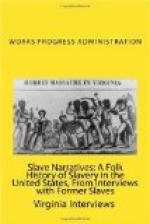“I was so small I didn’t know much about things then. When peace was declared a preacher named Hugh Brady, a white man, came here and he had my mother and father to marry over again.
“Mrs. Stephens’ father was one of the first school-teachers here for colored people. There were a lot of white people who came here from the North to teach. Peabody School used to be called the Union School. Mrs. Stephens has the first report of the school dated 1869. It gives the names of the directors and all. J.H. Benford was one of the Northern teachers. Anna Ware and Louise Coffman and Miss Henley were teachers too.
“Mrs. Stephens is the oldest colored teacher in Little Rock. The A-B-C children didn’t want the old men to teach us. So they would teach ’Lottie’—she was only twelve years old then—and she would hear our lessons. Then at recess time, we would all get out and play together. She was my play mama. Her father, William Wallace Andrews, the first pastor of Wesley Chapel M.E. Church, was the head teacher and Mr. Gray was the other. They were teaching in Wesley Chapel Church. It was then on Eighth and Broadway. This was before Benford’s time. It was just after peace had been declared. I don’t know where Andrews come from nor how much learning he had. Most of the people then got their learning from white children. But I don’t know where he got his.
“Wesley was his first church as far as I know. Before the War all the churches were in with the white people. After freedom, they drew out. Whether Wesley was his first church or not, he was Wesley’s first pastor. I got a history of the church.”
“They had a real Sunday-school in those days. My sister when she was a child about twelve years old said three hundred Bible verses at one time and received a book as a prize. The book was named ’A Wonderful Deliverance’ and other Stories, printed by the American Tract Society, New York, 150 Nassau Street. My sister’s name was Mollie Jackson.”
Interviewer: Miss Irene Robertson
Person interviewed: Lucy White, Marianna, Arkansas
Age: 74
“I was born on Jim Banks’ place close to Felton. His wife named Miss Puss. Mama and all of young master’s niggers was brought from Mississippi. I reckon it was ’fore I was born. Old master name Mack Banks. I never heard mama say but they was good to my daddy. They had a great big place in Mississippi and a good big place over here.
“I recollect seeing the soldiers prance ’long the road. I thought they looked mighty pretty. Their caps and brass buttons and canteens shining in the sun. They rode the prettiest horses. One of ’em come in our house one day. He told Miss Puss he was goiner steal me. She say, ’Don’t take her off.’ He give me a bundle er bread and I run in the other room and crawled under the bed ’way back in the corner. It was dark up under there. I didn’t eat the bread then but I et it after he left. It sure




